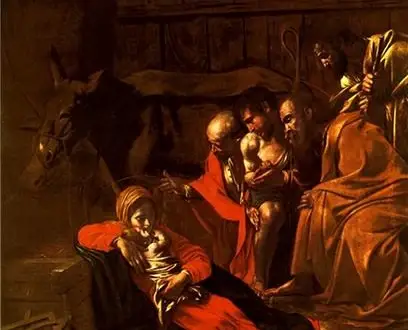Title of Artwork: “Adoration of the Shepherds”

Artwork by Caravaggio
Year Created 1609
Summary of Adoration of the Shepherds
Painting by Italian artist Michelangelo Merisi, better known as Caravaggio, entitled The Adoration of the Shepherds is an oil on canvas work. The Adoration of the Shepherds is 83.07 x 123.62 in. in size when completed. Commissioned by the Capuchin Franciscans, Caravaggio completed it one year before he died in 1609 for their church in Messina, the Church of Santa Maria degli Angeli.
All About Adoration of the Shepherds
Milan, Italy’s northern region of Lombardy, was the birthplace of Michelangelo Merisi, better known as Caravaggio, in 1571. An altercation with a police officer forced him to flee his home town.
Most aspiring artists go to Rome to learn the classical techniques, and he wasn’t the only one. Caravaggio had a reputation as a troublemaker and disobedient young man in Italy. He was frequently detained for alleged acts of violence.
A struggling Caravaggio was taken in by Cardinal Francesco del Monte and introduced to his circle, securing Caravaggio’s first public commissions. Flowers, fruits, and a young classical Greek god were all included in these commissions, which were not religious in nature. This is when he began to gain international acclaim for his paintings’ physical specificity and brutal realism. Artistically, Caravaggio had an epiphany in 1599.
Presumably under the direction of Cardinal Francesco de Monte, Caravaggio was contracted for the decoration of a wall in the Contarelli Chapel of San Luigi dei Francesi dedicated to Saint Matthew. In this work, Caravaggio made his first contribution to the Catholic Church as a painter.
A counter-reformation artist who used anachronistic techniques began to be seen as an artistic visionary for the Catholic Church. Because of the positive press, he was given the opportunity to work on more high-profile projects. It was initially criticised, but Caravaggio’s use of life rather than drawings revolutionised the term “artistic realism”.
Caravaggio died a year after completing The Adoration of the Shepherds in 1610, a year before his mysterious death.
In 1609, Caravaggio painted The Adoration of the Shepherds, he had developed a more spiritual expressiveness in his subjects. Against the vastness of the landscape, his figures appeared to stand out. A departure from the Renaissance practise of using decorative backgrounds, this was a stark contrast.
They were one of the few religious patrons who appreciated Caravaggio’s depiction of brutality. People were outraged by Caravaggio’s depiction of the Bible’s characters as “vulgar” peasants in his religious paintings. This scene is dominated by Mary, who occupies a central position. In a burst of colour, she’s dressed to the nines.
Her closest three shepherds each have a sliver of what looks like the same red robe draped across their arms. The Virgin Mary is holding Christ in her arms, and he could be making a gesture to touch her as he does so. At this baby born in a barn the shepherds and Joseph, who has a halo over his head, are awed and adoring.
In contrast to his Renaissance ancestors, Caravaggio’s Baroque work is strikingly different and revolutionary. It begins by depicting these divine figures as ordinary people of the time. They’re dressed casually, barefoot and in plain robes.
No, the barn isn’t filled with deity either. An event of this magnitude does not have a divine light source to illuminate the entire scene and make it obvious. Instead, the background is extremely dark, with only a single light source to illuminate it.
A single candle appears to have lit the room, as it might have been during the actual event. The Bible tells us that Mary and Joseph were extremely poor in the beginning of the story.
In contrast to the Renaissance’s elaborate headdresses, theirs are almost imperceptible. The only indication of religious significance in the painting is the clasped hands of the shepherds. Christ’s birth was not sensational in any way. Caravaggio’s depiction of this aspect is flawless.
Information Citations
En.wikipedia.org, https://en.wikipedia.org/.
























